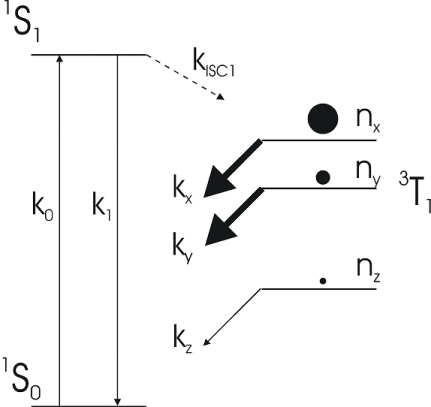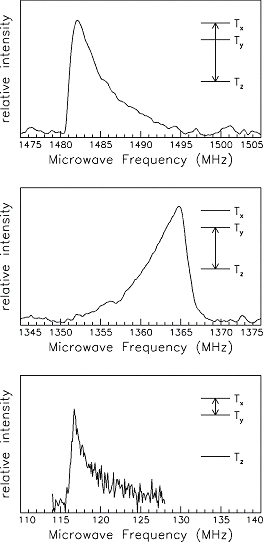Optical deteced magnetic resonace
A. General Idea
The sensitivity of magnetic-resonance spectroscopy can be enhanced tremendeously by exploiting double resonance techniques. Optically-detected magnetic-resonance is based on the idea to transfer the detection of a microwave absorption or emission to the optical domain and to take advantage of the concomitant increase in photon energy to enhance the sensitivity of the experiment. Here the basic principles of Fluorescence-Detected Magnetic-Resonance (FDMR) will be explained on the example of the organic molecule pentacene. For other molecules the population and depopulation rates will be different. The more general case is treated in section B.
For simplicity only the case without an external magnetic field will be treated. Since the eigenfunctions in the presence of a magnetic field are linear combinations of the zero-field states there is no principal restriction of FDMR to zero-field experiments.
FDMR works as follows, pumping the S1←S0 transition with a laser leads to a steady state population of the triplet state of pentacene as indicated in figure 1.

Figure 1: Schematic representation of the pumping cycle for an organic dye molecule. The actual population distribution for the triplet sublevels refers to pentacene in p-terphenyl.
The size of the circles and the thickness of the arrows indicate the relative steady-state populations nu and decay rates ku of the triplet sublevels for pentacene in p-terphenyl. Magnetic-dipole transitions between any two of the triplet sublevels are possible. If for instance the Tx and Tz levels, which have the largest population difference are coupled by resonant microwaves, some population of the short-lived Tx level will be transferred into the long-lived Tz level. The consequence is that more molecules per unit time will be in the triplet state or, equivalently, less molecules reappear per unit time in the ground state. If there are less molecules available in the ground state, less molecules can be excited to the 1S1 state leading to a decrease of the fluorescence intensity. The, on first sight, surprising consequence is that a resonance in the triplet manifold leads to a change of the fluorescence between the singlet states. But of course the steady-state populations of all five states are determined by the transition rates between them and any change of these rates will lead to a redistribution of population in all states.
B. General Case
A more quantative description of FDMR is achieved by analysing the rate equations for the populations of the five levels involved. If N is the total number of molecules it follows
(1)

where [1S0] denotes the number of molecules in the 1S0 state and similarly for the other states. Due to the short lifetime of the 1S1 state the population of this level is negligible with respect to those in the other two states which yields
(2)

For the description of the temporal development of the populations it is assumed that no spin-lattice relaxation between the triplet sublevels occurs, a condition which is fulfilled at sufficiently low temperatures. Under this assumption it follows
(3)

where for the triplet state populating rates the relative populating probabilities Pu (Px+Py+Pz=1) have been used, which are related to the populating rates pu by pu = kisc1×Pu. For steady-state conditions one obtains from (3) for the total triplet population
(4)

Applying microwaves which saturate for example the Tx - Tz transition, equalises the populations of the two triplet states and the populating and decay rates of the triplet sublevels will change in first approximation to
(5)

and
(6)

where the primed rates refer to the situation in presence of the microwaves. For the total triplet population under influence of the resonant microwave field one obtains now
(7)

From (2) it follows that a change in the triplet population is accompanied by a change in the 1S0 population and can be expressed as
(8)

The fluorescence intensity, however, is directly related to the population of the 1S0 state which yields that the change in fluorescence intensity is proportional to Δ[1S0] which is given as
(9)

As expected an increase in triplet population corresponds to a decrease in the fluorescence intensity. From (4) and (7) one obtains
(10)

for the Tx - Tz transition. Similar equations can be obtained for the other two transitions which shows that a change in the fluorescence, a FDMR signal, is observable only if both the steady-state populations and the decay rates of the two triplet sublevels involved in the magnetic resonance differ from each other.

Figure 2: The three optically detected zero-field transitions of the lowest excited triplet state of pentacene for an ensemble of molecules. From top to bottom the respective transitions are between Tx - Tz, Ty - Tz, and Tx - Ty as indicated. Each spectrum corresponds to a decrease of the fluorescence intensity with respect to the steady-state fluorescence intensity without microwaves. The vertical scale is different for each spectrum. The Tx - Ty spectrum shows a relatively weak signal due to the small differences of the respective decay rates.
As an illustration the three zero-field transitions of the lowest excited triplet state of an ensemble of pentacene molecules are shown in figure 2. The triplet sublevels between which the resonance occurs are indicated in the insets. Each transition appears as a decrease of the fluorescence intensity and features an asymmetric lineshape. For the Tx - Tz and Ty - Tz transitions the microwave-induced change of the fluorescence intensity is about 0.3%. The signal that results from the Tx - Ty transition is much smaller which is consistent with the conclusions about (10) because only a small signal is expected resulting from the very small, experimentally unresolved, difference of the Tx and Ty decay rates kx and ky.
Literature
R.H. Clarke
Triplet State ODMR Spectroscopy, (1982), Wiley, New YorkH.Haken, H.C. Wolf
Molecular Physics and Elements of Quantum Chemistry, Springer, Berlin

